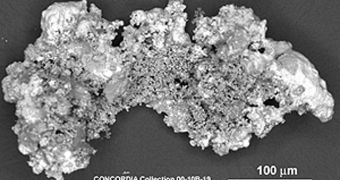Astronomers propose that micrometeorite bombardments were primarily responsible for the cooling of early climates on Mars and Earth, nearly four billion years ago. During these events, pieces of space rock no bigger than a sugar grain swooshed through the two atmospheres at great speeds.
Scientists behind the new research say that the bombardments nearly deprived the planets of their ability to support life. In Earth's case, the development of the most basic lifeforms was arguably delayed by at least a few hundred million years.
In a paper appearing in the April 2 issue of the journal Geochimica et Cosmochimica Acta, researchers with the Imperial College London (ICL) detail the effects of an event known as the Late Heavy Bombardment (LHB).
During this epoch, which happened as the solar system was still very young, Earth, Mars and the other two inner planets were barraged with meteorite showers that lasted in excess of 100 million years.
At the time, the climates of Earth and Mars were not very well defined. Regardless, they were completely transformed by the LHB, as the space rocks infused vast quantities of sulfur dioxide into what passed as air at the time.
According to the ICL team, the micro-meteorites came from the Inner Asteroid Belt (IAB), a region of space located between the orbits of Mars and Jupiter that contains millions of such objects.
As they entered the atmosphere under the influence of Earth's gravitational pull, the minute particles heated up to about 1,000 degrees Celsius, releasing a mix of gases including sulfur dioxide. This chemical, once infused in the atmosphere, generated a large amount of aerosols.
These are solid or liquid airborne particles, which have a direct influence on the amount of sunlight reaching the planetary surface, and also on how much sunlight is reflected back to outer space.
Calculations conducted by the ICL team suggest that the LHB infused Earth's atmosphere with about 20 million tons of SO2 annually. On Mars, nearly 500,000 tons of SO2 were infused each year. The process went on for around 100 million years.
“Far less of the Sun's energy was reaching Earth 4 billion years ago, which would have made it hard for early life to emerge,” explains ICL Department of Earth Science and Engineering professor Mark Sephton, one of the study authors.
“Recently denied of its protective magnetic field and constantly subjected to large meteorite impacts, Mars was also starting to lose its greenhouse gases at this time, causing global cooling,” he adds.
“The influx of sulfur dioxide into the Mars' atmosphere would have dealt a further blow to a planet already on the ropes, making conditions for life even more of a challenge,” the expert concludes, quoted by PhysOrg.

 14 DAY TRIAL //
14 DAY TRIAL //